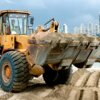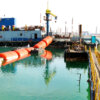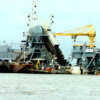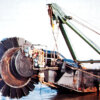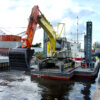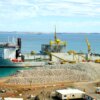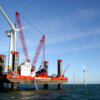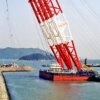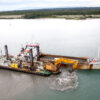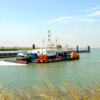Plain suction dredgers are stationary dredgers positioned with wires and with at least one dredge pump connected to a suction pipe and a delivery pipe.
Types of suction dredgers
Suction dredgers can be divided into four types:
- standard plain suction dredgers which discharge dredged material directly through a pipeline to the reclamation area
- barge loading suction dredgers which are used when the transport distances to the placement area are too far for direct pumping
- deep suction dredgers which are equipped with underwater pumps for dredging depths exceeding 30 metres
- dustpan dredgers which have very wide suction mouths.
Work method
Suction dredgers may be stationary or self-propelled, although self-propulsion is evident only when moving the equipment to a new dredging site. When they are working, suction dredgers are always stationary.
Suction dredgers make use of the “breaching” process. Breaching occurs when continuous and/or local instabilities on a sandy slope cause a density flow to run downwards from the slope. Suction dredgers create this breaching effect intentionally. Suction dredgers do not have cutter heads. Instead they use centrifugal pumps to provide the flow for entraining, that is, carrying the material along in currents, and hydraulic transport to carry the solid/water slurries from the dredging site through a pipeline to the surface and then to the discharge site.
Jet water pumps
Most suction dredgers are equipped with jet water pump(s) to assist either the breaching process or to improve the mixture forming process near the suction mouth. The suction pipe is situated in a well in front of the pontoon.
Advantages
Suction dredgers can dredge at great depths using ladder-mounted centrifugal pumps to enhance production and water jets to fluidise the material to be dredged.
Production rates
Good production rates can be achieved by these dredgers when the sediment is free running sand or the cut or breach height is sufficient, at least 10 metres. When the materials are suitable, suction dredgers have high production rates.
Project applications
Suction dredgers are effective in unconsolidated materials and are used extensively in aggregate-winning operations and large reclamation projects.
They are rarely suitable for use in channel or harbour construction projects, because of their inability to handle consolidated materials and the deep pits that they typically excavate. In all cases, the dredged sediment is discharged through pipelines or by barges.



